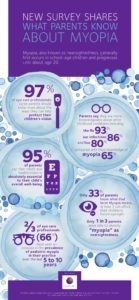Sponsored content
Feb. 20, 2020
By Michele Andrews, OD
Eye care professionals (ECPs) know firsthand that there’s a lot of confusion among parents about what myopia is, how it progresses and how to treat it. Given the dramatic increase in the prevalence of myopia among children, this lack of parental knowledge is hindering our efforts to provide the best care.
One in four children in the United States is myopic1, but according to The Harris Poll survey results released in late 2019 by CooperVision, two out of three parents don’t know what that term means2 or how it can affect their children’s eyesight. The survey was conducted among eye care professionals, including 155 optometrists, 158 ophthalmologists and 1,005 parents with children 8-15 years old.
More highlights from the survey include:
- Ninety-seven percent of ECPs agree parents should know more about the ways they can help protect their children’s vision.3
- Seventy-three percent of parents strongly/somewhat agree that teachers are more likely to notice that children have vision problems 2; 68 percent of parents strongly/somewhat agree that school nurses often notice potential vision problems among children before parents.2
- Parents say they are more knowledgeable about other common childhood ailments including the flu (93 percent), ear infections (86 percent) and lice (80 percent) compared with their knowledge of myopia (65 percent).2
- Twenty-two percent of parents report the top reason prompting an ECP visit is an in-school eye screening2, whereas 92 percent of ECPs state this is the top reason for parents seeing them for their child’s vision.3
Along with providing an effective myopia management plan for pediatric patients, we need to teach parents about the long-term eye health risks of myopia and the importance of early treatment. Even a modest level of myopia can have consequences. Most kids don’t know they don’t see well, and its impact on development can be significant. Children need clear vision to learn.
When introducing parents to myopia, it’s vital to use everyday language when describing what myopia is and why it happens. A model of an eye can help to show what elongation is, how it can change over time and why it matters. Parents will benefit too in learning unfamiliar terms related to myopia if you send them home with printed information or direct them to web resources aligned with your approach to myopia management.
Parents who are myopes will likely understand what the experience will be like for their child. For a child with one myopic parent, research shows a 25 percent chance of developing myopia, and that risk rises to 50 percent with two myopic parents.
Parents also need to know about environmental factors that promote myopia progression, such as prolonged close work and limited exposure to sunlight. As children enter school and spend more time on electronic devices and textbooks, parents can modify their child’s daily activities. ECPs should recommend at least 120 minutes of outdoor time per day, including breaks during school, and limiting screen time. Introduce children and parents to the 20-20-20 rule, which encourages taking a 20-second break to view something 20 feet away every 20 minutes.
An essential point for parents to learn is that treating myopia means more than just glasses or contact lenses. That widely held belief could keep parents from taking advantage of therapies that can help slow the progression of myopia and thus avoid serious eye health complications later in life. Help them learn about myopia management options and emerging treatments, such as soft contact lenses.
Managing myopia also means having an ongoing relationship with a pediatric patient and their family, so you’ll need to stay abreast of the latest treatment options. New myopia management strategies and new therapies are emerging and will continue to do so. The most recent example is CooperVision’s MiSight®1 day contact lens, which won approval in November from the U.S. Food and Drug Administration. It is the first and only FDA-approved product clinically proven to slow the progression of myopia (nearsightedness or shortsightedness) when initially prescribed for children 8-12 years old. CooperVision this year launched its Brilliant Futures™ myopia management program to help ECPs learn how to take full advantage of this new opportunity.
This is a challenging and exciting time for managing pediatric myopia. Advances in treatment options will continue to emerge, and public awareness will grow. That means more parents will be coming to you with questions, so being prepared for those conversations will help you provide the most effective care.

Michele Andrews, OD, is senior director, North America Professional and Academic Affairs, at CooperVision.
References:
- Cooper, Y. (2019, May 1). With Childhood Myopia Rates on the Rise, the American Optometric Association Highlights the Importance of Early Intervention through Annual Eye Exams. Retrieved from https://www.aoa.org/newsroom/myopia-rates-on-the-rise-syvm
- CooperVision data on file 2019. Myopia Awareness, The Harris Poll online survey 6/27/19 to 7/18/19 of n=1,005 parents (with child age 8-15) in the U.S.
- CooperVision data on file 2019. Myopia Awareness, The Harris Poll online survey 6/27/19 to 7/18/19 of n=313 ECPs (who see at least 1/month myopic child, age 8-15) in the U.S.











